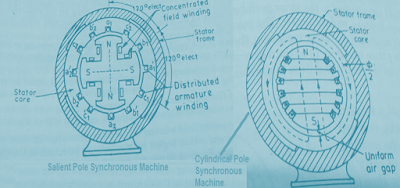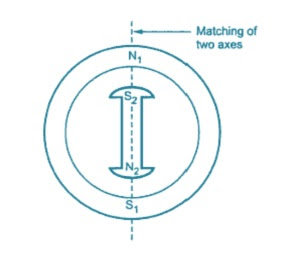As we know that, the configuration of Armature and Field Winding is reverse in Synchronous Machine compared to DC machine i.e. Armature is on stator and field winding is on rotor unlike DC machine where it is opposite. In alternator the rotor part constitutes field winding so if we give DC supply to field winding constant field is developed and we make the rotor rotate so that flux will be rotated and it cuts the conductors in stator and emf is induced in the armature winding.
Now, we what will happen if we give AC Supply to the Field Winding of a Synchronous Machine.
Effect on Synchronous Motor:
Suppose, we are supplying AC to the Field Winding of a Synchronous Motor. In a Synchronous Motor, a rotating magnetic field is produced in stator by giving 3 phase AC supply. Now as per working principle of Synchronous Motor, rotor must have a magnetic locking with stator field. For this purpose we need permanent magnetic poles in rotor so that rotor pole will form magnetic locking with nearest opposite pole of rotating stator field and rotates with stator field at synchronous speed.
If AC excitation is given then alternate North and South Pole is created on rotor field the rotor move half cycle clockwise and half cycle anti clockwise and finally stops to rotate. Thus we see that the Synchronous Motor will stop rotating.
Effect on Synchronous Generator:
Suppose that an Alternator is running at Synchronous speed by prime mover and its Field Winding is supplied by AC source. As the Field Winding is excited by AC source, an alternating / pulsating magnetic flux will be produced.
Now using Double Field Revolving Theory, this magnetic flux produced by Field winding can be resolved into two components- one revolving in the forward direction at Synchronous Speed (w) and another revolving in backward direction with synchronous speed -w.
So, Relative speed of backward rotating field w.r.t Stator = 0 as the rotor speed = w = Synchronous speed
Therefore,
The armature conductor at Stator will not see any change in flux due to backward rotating field flux and hence no EMF will be generated in the Armature Terminal of Alternator.
Now, the Relative speed of forward rotating field flux w.r.t Stator = 2w
As the relative speed of field flux is double, therefore the EMF generated in the Armature Terminal will be at a frequency of 2f. Also, because of higher frequency i.e. 2f of generated emf, the core losses will increase and Alternator / Synchronous Generator efficiency will decrease.
Thank you!


Sir you said due to double field revolving theory relative speed will be zero.Then how after that we assumed that the forward relative speed to double??
See, as the rotor produced flux is pulsating, hence it is resolved into forward and backward rotating flux with synchronous speed.
So, Speed of Rotor = w
speed of backward rotating field = -w
speed of forward rotating field = -w
Hence, relative speed of backward rotating field w.r.t stator = w+(-w) =0
But,relative speed of forward rotating field w.r.t stator = w+(w) =2w, hence double
great explanation thanks
thanks
Thank you vamsi!
ac alternates , wiggling back and forward good for vibrator no use for a wheel . takes a different sort of drive creation in the motor as its push pull not a flow. same total power at one end does nothing bar highlight the zero power doesnt compute in that language , synchronous not asynchronous motor